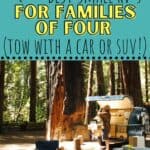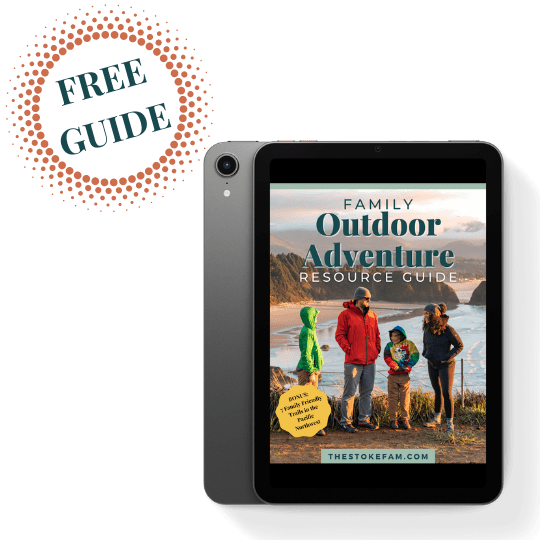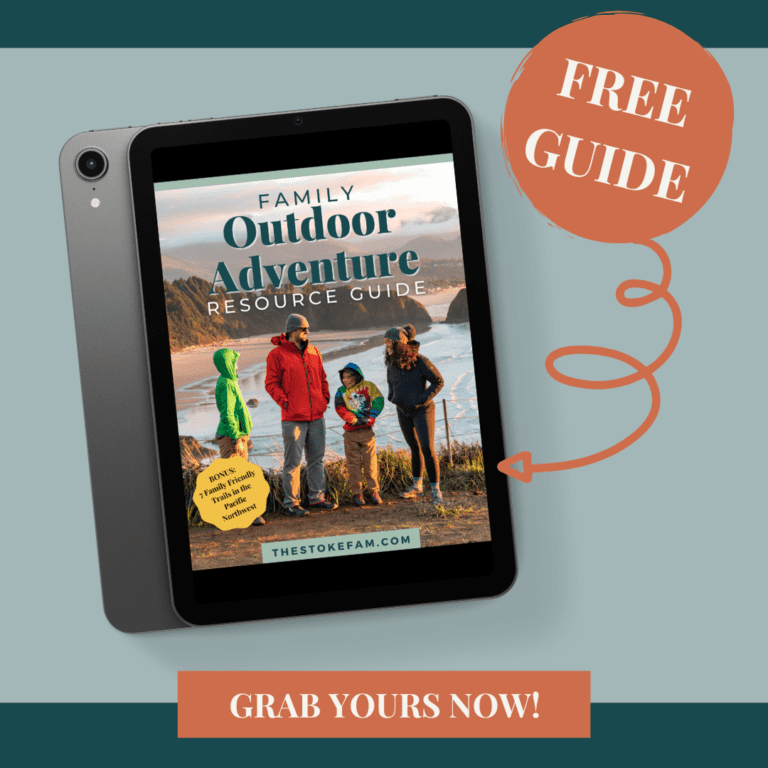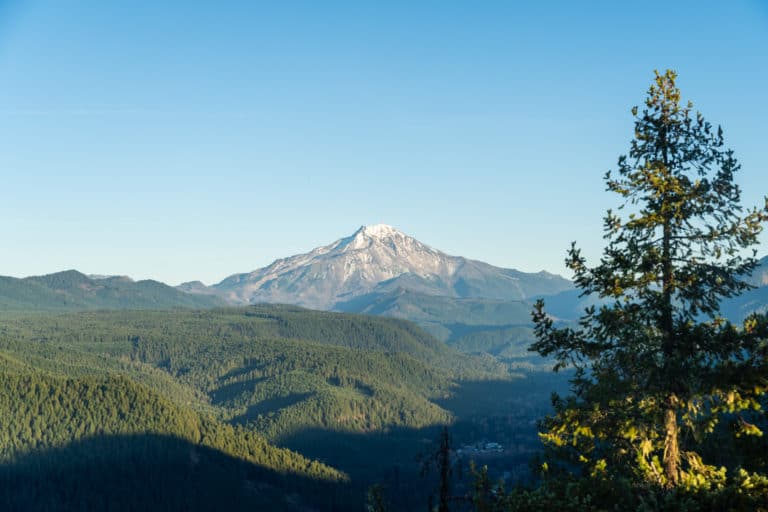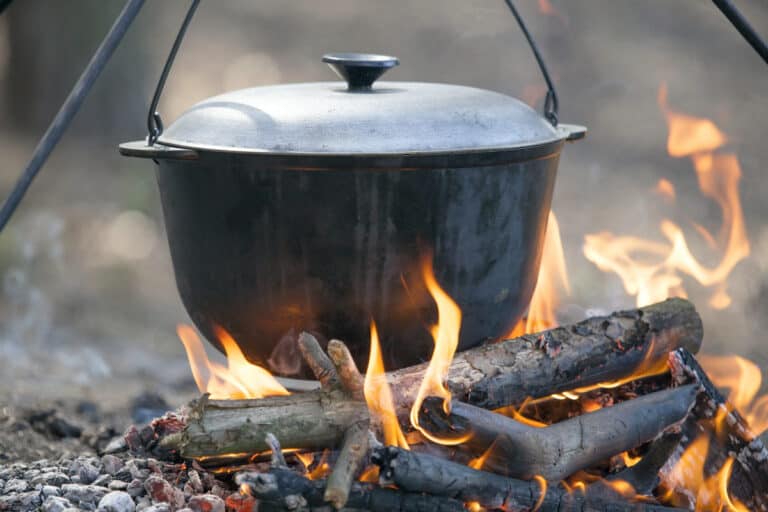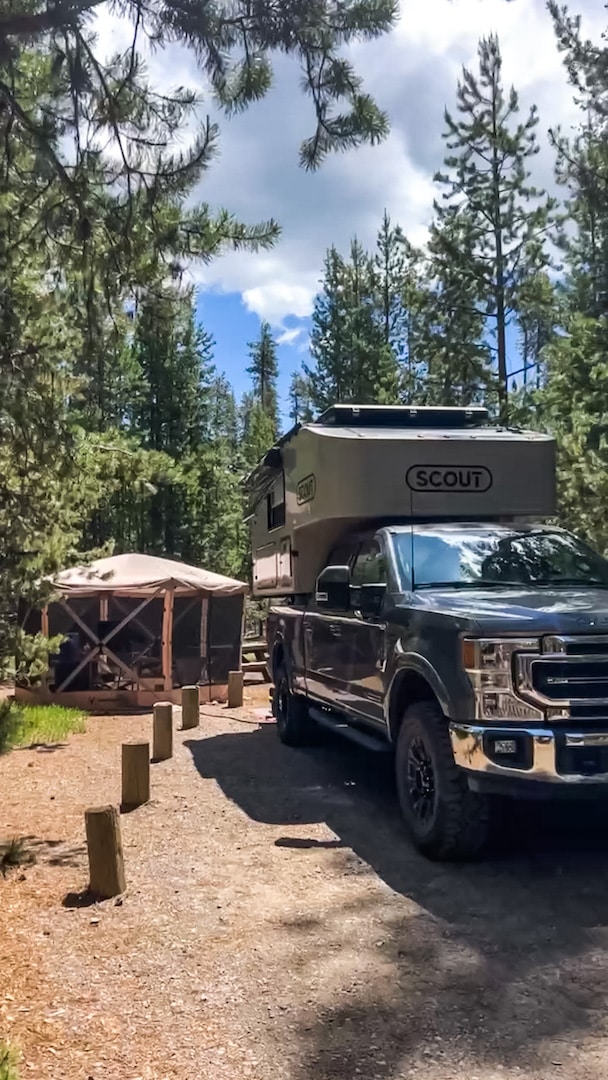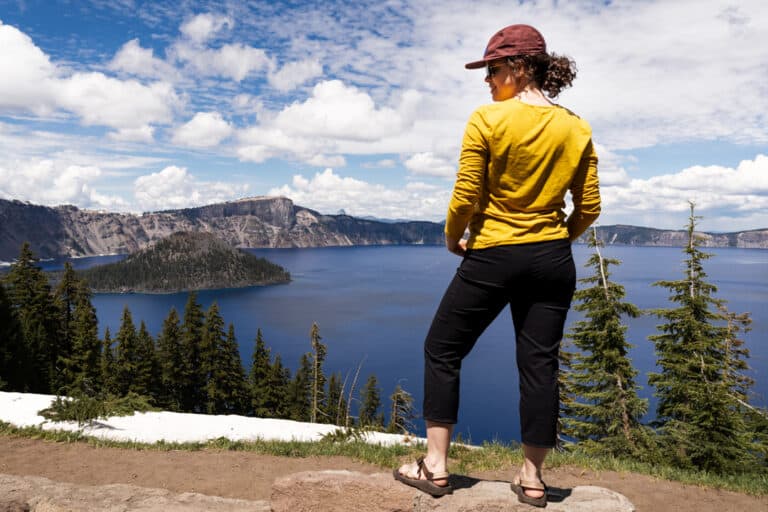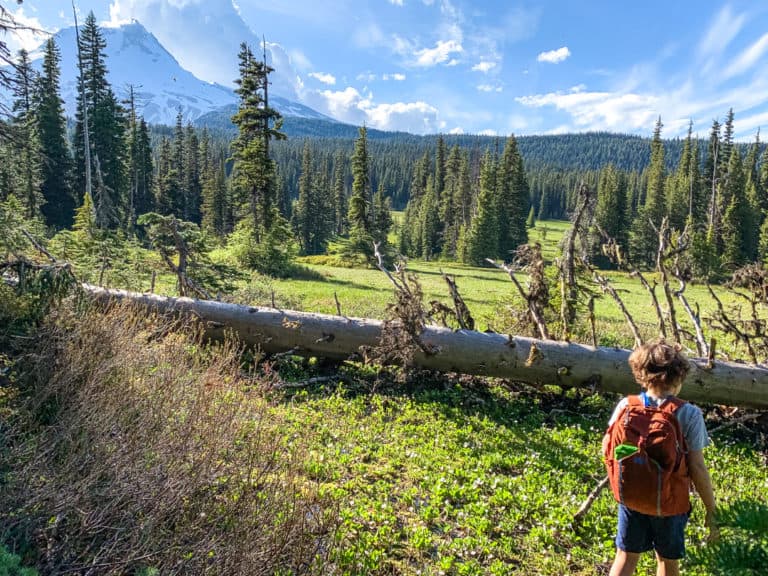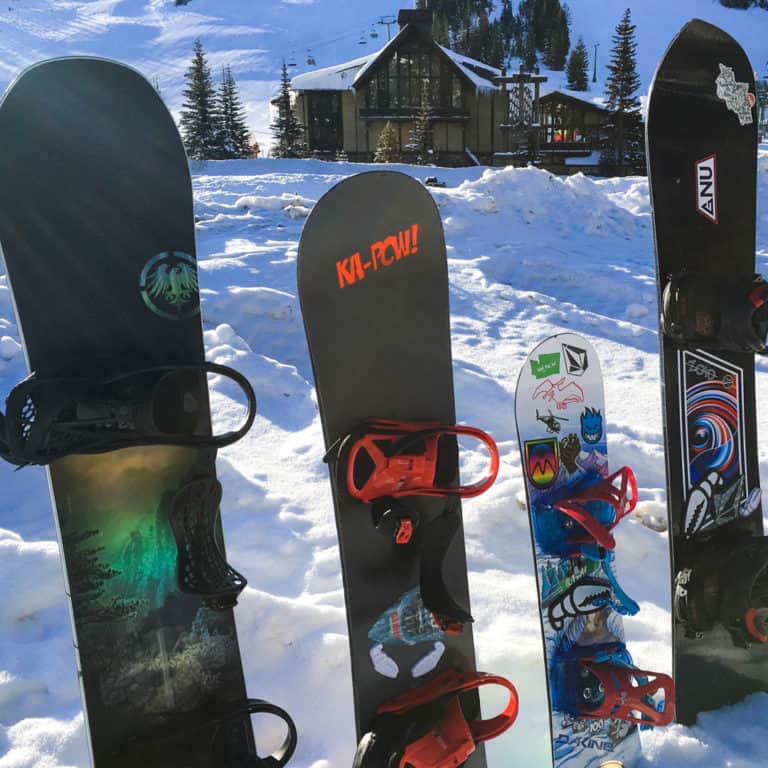It’s more complicated than you’d think to find the best small RV for a family. Many small campers are set up perfectly – for a couple. Or maybe a family of three with a baby or toddler.
But, as your family grows, it gets more challenging to find a camper that can fit your soon-to-be adult size kids. 😅
We get it. As a family of four, we started the process of researching and planning for our perfect small camper almost two years ago.
I think we considered every option out there – campervans, travel trailers, teardrops, offroad trailers, and truck bed campers, just to name a few. We visited RV lots, RV shows and spent countless hours researching before deciding on the ideal solution for us.
The best part? Our hours of research led us not only to the best option for our family of four but also to several more great choices that might be perfect for yours. And I’m going to share them all with you in the next few minutes.
I’ve pulled together our favorite small RV’s for a family of four in multiple categories, pros and cons of each, and – of course – which one we chose for our family.
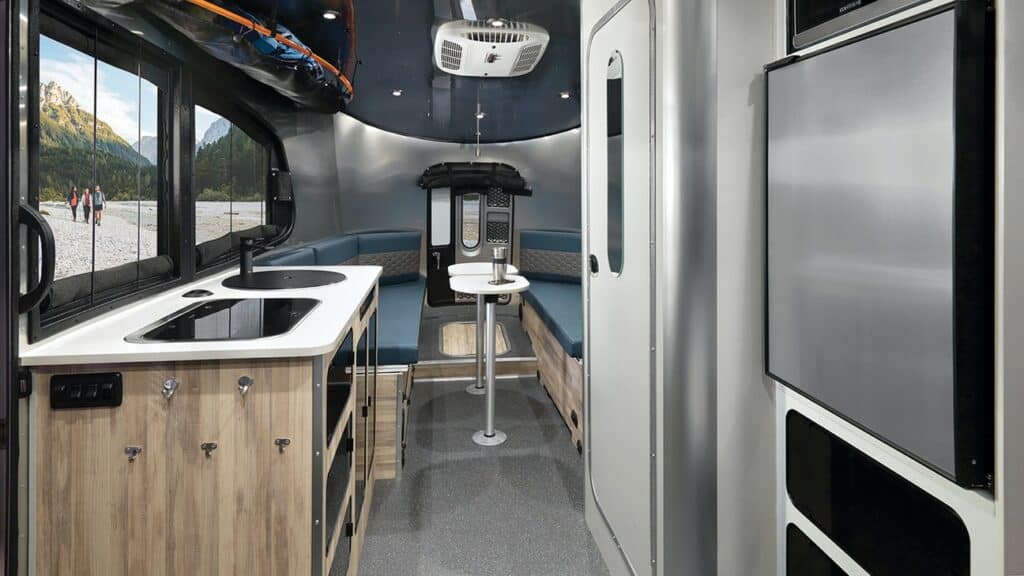
Why choose a small camper?
Though reasons for choosing a small RV for a family of four can vary, for us, the decision to choose a small camper came down to a few key items.
- Manueverability – A smaller RV is easier to manuever – period. I knew that if I were ever going to take trips on my own with the kids, I would be way less stressed if I wasn’t towing 30 feet behind me. Plus, one of the biggest things we were looking for was the ability to tackle forest service roads and overlanding.
- Maintenance – Look, I’m just going to be honest. I already have a house to clean and maintain. I don’t need a second one. That might change if we ever decide to travel full-time, but we wanted something easy to clean with minimal maintenance and fewer features to break.
- Lightweight – We do a lot of winter travel and snowboarding, so the idea of pulling a long, heavy RV on snowy roads is not appealing in the least to us. Plus, a lightweight RV leads me to my next reason to choose a small RV.
- Gas – The bigger the RV, the more gas (and money) it will take to travel with it. We wanted to choose an option that would preserve our mileage as much as possible.
- Storage – We wanted an option that we could store at our house. Luckily, we don’t have an HOA, so there are no rules against it, and we keep it neat, of course. We decided if we had to store our RV away from the house, we would be less likely to use it as often. And, why pay for something if you don’t use it enough to justify the cost?!
A Note About Lead Time
Before we get into our best picks, I want to mention a little thing called lead time. If you’re not familiar with the term in the RV world, lead time is essentially the time between when you initiate your order and when your order is complete.
Unfortunately, as of October 2021, the lead time on many RV’s, travel trailers, and campers are a MINIMUM of 6 months. In reality, many are taking up to 18 months for delivery. As you’re shopping, I think it’s important to know this early in the process so you can plan accordingly.
Thankfully, many companies have a reasonable down payment to secure your spot, and you can wait to pay the remainder, via cash or financing, until delivery. For reference, on our camper, we paid $500 to reserve our spot in the production line on December 28, 2020, and paid the remainder on August 3, 2021, when we took delivery.
Best Small Travel Trailers & Offroad Camping Trailers
First, let’s talk about the best travel trailers under 5,000 pounds. There is no shortage of small trailers on the market today, but these are our favorites in this category.
Aero Teardrops Sellwood Retro Style Trailer
First up is the Aero Teardrops Sellwood Retro Style Trailer, and I have to say that this is one of the cutest trailers on our list. It instantly makes me think of my childhood days and my great-grandparents – until I look inside at all the extra features, that is.
- Sleeps: 4
- Bed arrangement: Convertible dinette (35” x 79”) and convertible couch (50” x 80”)
- Length: 13 ft.
- Base weight: 2500 lbs.
- Starting price: $26,499
- Additional info
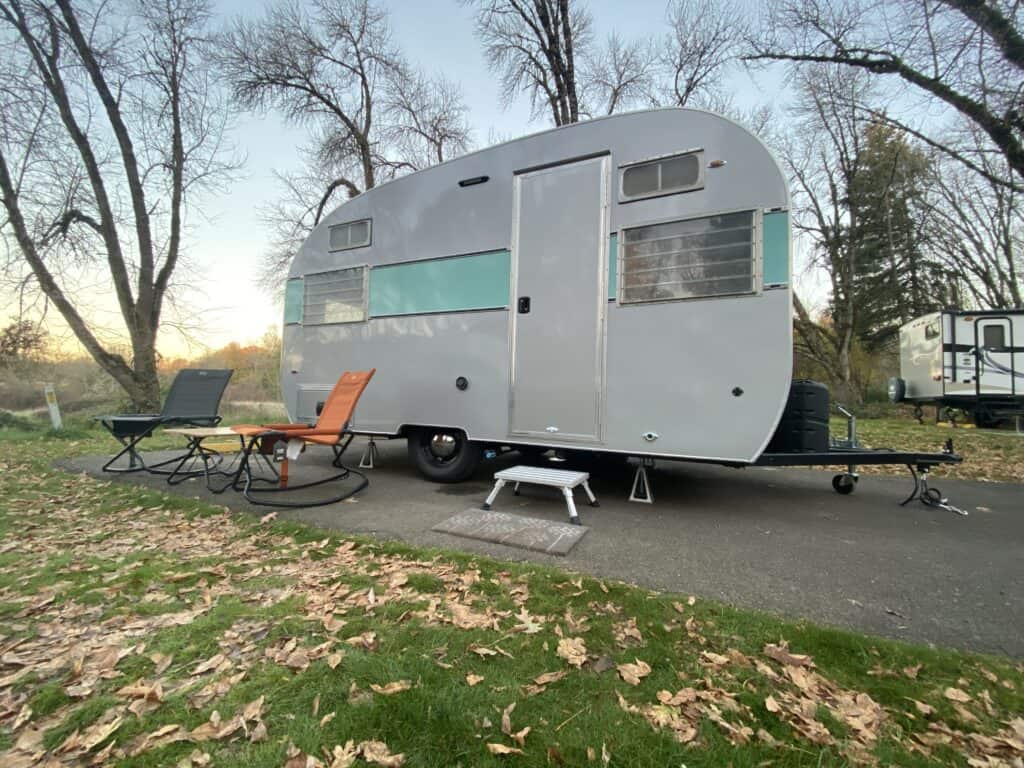
Pros
The Sellwood has a sleeping capacity to fit four people, a fully equipped kitchen, and on-demand hot water. Plus, standard features include a Bluetooth stereo and flat-screen TV with a DVD player! You can even customize the size band color on your trailer!
In addition, you have the choice of an option with and without a bathroom, so you can decide which is best for you (and your wallet). You can also add an optional hammock for sleeping space, which brings me to the cons.
Cons
Both of the beds are convertible options, and the dinette is only a twin size. So, unless your kids are super tiny, you’ll need that optional hammock to truly sleep four.
Taxa Outdoors Cricket
The Taxa Outdoors Cricket is a true lightweight travel trailer with a base weight of only 1753 pounds with some pretty sweet features, including a two-burner stove and a 5000 BTU air conditioner.
- Sleeps: 4 (2 adults and 2 small kids)
- Bed arrangement: Dining area converts to a full-size bed (75” x 59”), optional berths for 2 kids (60” x 22”)
- Length: 15’
- Base weight: 1753 lbs.
- Starting price: Approximately $29,000
- Additional info
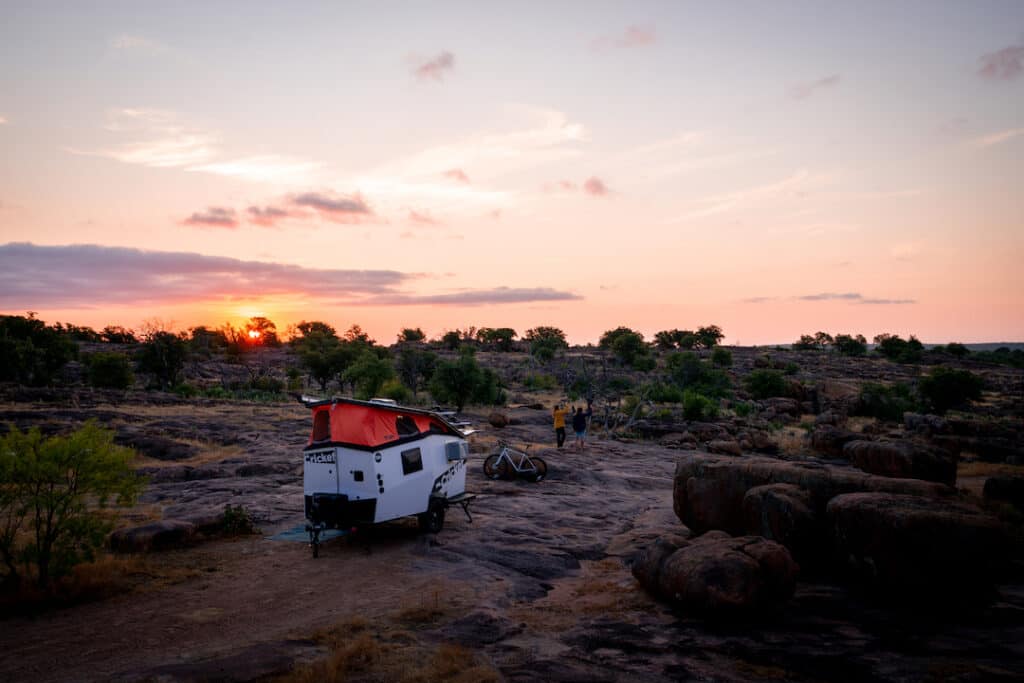
Pros
This smaller camper trailer is made with a rugged design for all your adventures, and we love the pop-up roof design for extra height and ventilation. In addition, the optional berths for kids allow for additional sleeping space with a smaller footprint and lighter weight.
One of the best things about this particular model is because this is such a lightweight trailer, it can be towed with almost any vehicle (though don’t forget to take the weight of your family and gear into account).
Cons
While the optional berths are excellent for small children, they may present a challenge as your kids grow with a weight capacity of 130lbs and a length of 60″. My 11 year old would already be too long for these. 😅
Taxa Outdoors Mantis
Though the Cricket and the Mantis are both made by Taxa Outdoors, they have completely different floor plans, and we have to say we love the additional space and sleeping arrangements in the Mantis.
- Sleeps: 4+
- Bed arrangement: Dining area converts to a full-size bed (78” x 54”) with under-bed storage, Folding couch converts to a bunk bed (76”x22” and 77” x 26”), Optional Thule Tepui 3-person rooftop tent, optional hammock.
- Length: 19’
- Base weight: 2972 lbs.
- Starting price: Approximately $41,000
- Additional info
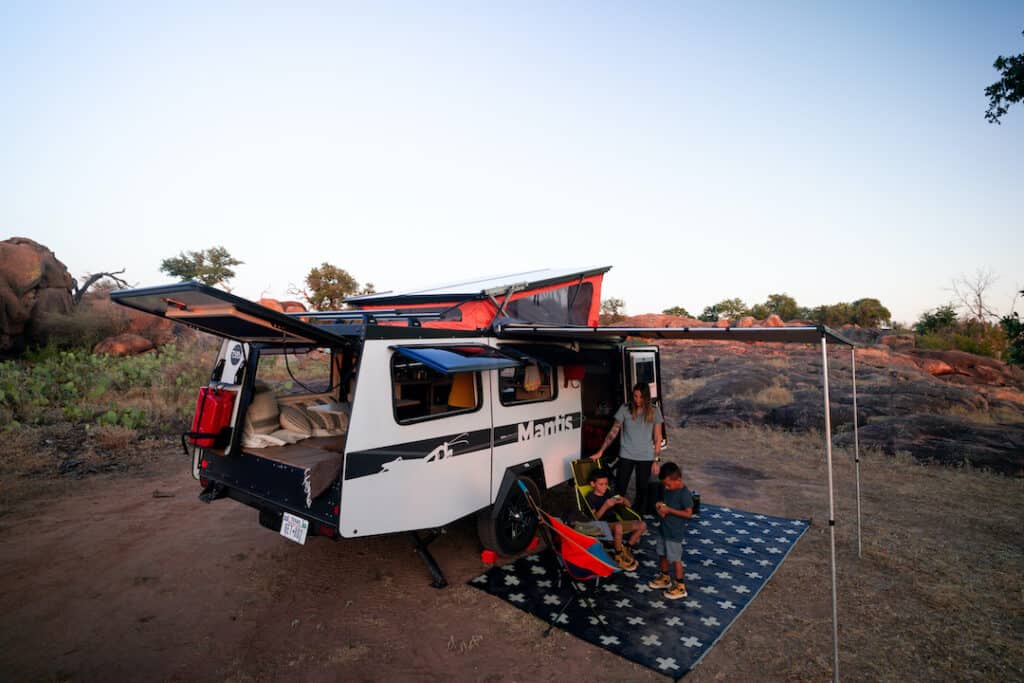
Pros
Like its little brother, the Mantis is made with a rugged design and pop-up roof for height and ventilation. With the extra space, you also get more living space as well as larger freshwater (20 gals) and greywater (22 gals) tanks.
Most significantly, though, is the additional sleeping space to more easily fit the entire family – plus friends! With the convertible dining area, folding couch bunk bet, rooftop tent, and hammock, you could potentially sleep up to 8 people!
Cons
All that extra space does come with some cons. The Mantis is over 1,000 pounds heavier than the Cricket and four feet longer, limiting your options for tow vehicles. Plus, you’ll have to shell over more cash on those monthly payments (or upfront) for the extra space.
Airstream Basecamp 20X
Did you know the first Airstream factory was built in the 1930s?! Needless to say, they are no stranger to the RV world, and one of the newest additions to their lineup is the Basecamp. It comes in two models, the Basecamp 16, which sleeps 2 (so it’s not included on our list), and the Basecamp 20, which sleeps 4!
- Sleeps: 4
- Bed Arrangement: Bench seating that converts to a full bed (41” x 78”) and Convertible dinette (43” x 78”), though the shapes are unique.
- Length: 20 ft
- Base weight: 2,635 lbs
- Price: $48,300+
- Additional info

Pros
The Basecamp 20 on its own is a solid trailer camper that can take you where you want to go. Still, one of our favorite features is the ability to upgrade to the Basecamp 20X, which is the model we are highlighting here. The addition of the X-Package gives you rugged features to allow you to truly get off the beaten path with things like a 3” lift kit, all-terrain tires, stainless steel rock guards, and more.
In addition, you have color choices when it comes to the interior decor, the ability to add an optional attachable tent, and that window is incredible!
Cons
Airstreams have always had a unique shape, and the Basecamp 20X is no different. However, that also means beds that are a little oddly shaped. In addition, this definitely isn’t the cheapest small RV on our list at a starting price of $48,300 for the Basecamp 20X (the standard Basecamp 20 will save you about $7,000).
Black Series HQ12
When it came to choosing our own camper, Black Series was high on our list. Truth be told, they were our front runner for a long time (with the HQ17), though ultimately, we made a different choice. Many of our favorite features from the HQ17 are also present on the HQ12.
- Sleeps: 4
- Bed arrangement: Queen bed, overhead bunk, pullout table that converts into a bed
- Length: 19 ft.
- Base weight: 4422 lbs
- Starting price: $65,999
- Additional info
Pros
Black Series was at the top of our list for an offroad camper trailer because they are fully self-contained, ruggedly built, have BOTH an indoor and outdoor kitchen. Not to mention, they still manage to put it all together in a luxurious package. Another huge perk is the inclusion of a Dometic DF Series Furnace to keep you warm on those cold nights.
Black Series should definitely be a top contender if you plan to do any off-roading or dispersed camping. With independent suspension, a quad shock design, a rugged exterior, and more, they are created to go wherever you go.
Cons
The biggest con for the HQ12 is the price. With a starting price of over $65,000, this is one of the most expensive travel trailers on our list. In addition, during our research, we found that if you plan to use it throughout the winter instead of winterizing and storing it, you will likely want to add on a winterizing package from your dealer on top of the already steep price. Though, if you’re willing to part with that much cash, you’ll have one of the coolest rigs out there.
Opus OP15
When it comes to luxury and rugged features, the OP15 is one of the first options that comes to mind. This camper is full of options to make your adventures comfortable and has enough space to fit a family of four.
- Sleeps: 4
- Bed arrangement: King bed (76” x 71”) and Bunk Beds (80” x 45”, 80” x 33”)
- Length: 257” travel mode, 280” at camp
- Base weight: 4960 lbs
- Starting Price: $53,000
- Additional info
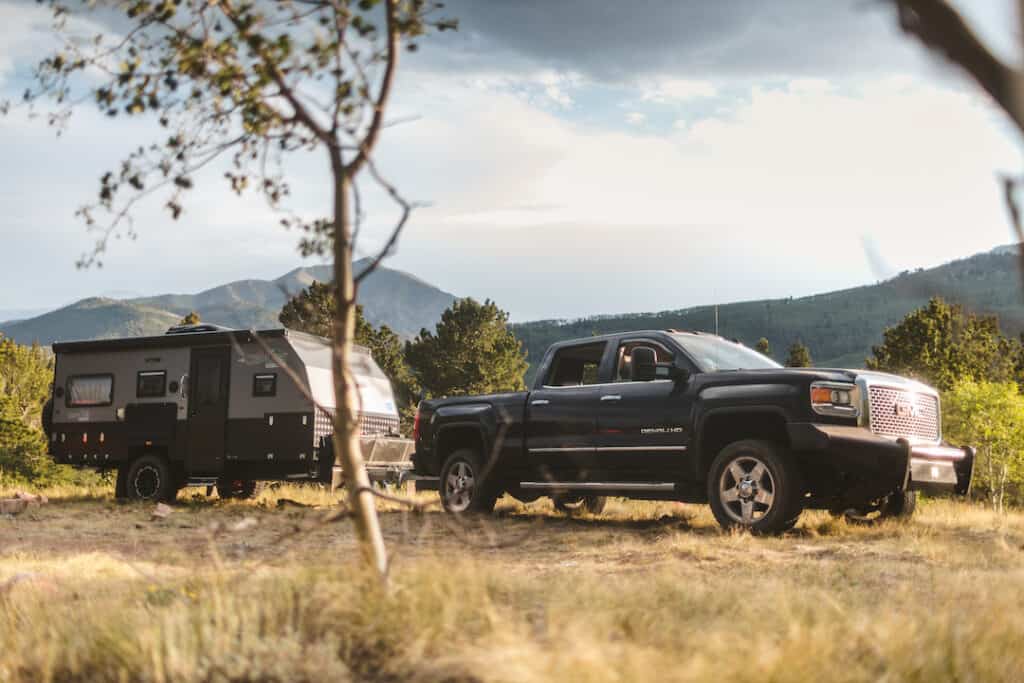
Pros
This camper has one of the most beautiful interiors we have seen in an off-road camper. The solid bamboo drawers provide plenty of storage, and we love how the bunk beds are permanently set up – plus, the curtains are a nice touch for a bit of privacy.
In addition, we also love how the roof pops up at camp for extra room and ventilation but closes for a lower profile when towing.
Cons
This isn’t the cheapest camper trailer on our list, though it does make up for most of the price in features and design. In addition, it’s quite a bit heavier at its base weight of 4960 lbs, so if you need to stay under 5,000 lbs total, including your gear, this option won’t work for you.
However, for us, the biggest drawbacks are the lack of an indoor kitchen (even though we’re in love with the outdoor kitchen) and heater. Because many of our adventures include winter trips in snowstorms here in the Pacific Northwest, an option with a heater and the ability to cook indoors was a must. Of course, I’m sure we could have found add-on solutions, but we would prefer not to at this price point.
Boreas EOS-12 Camper Trailer
The Boreas EOS-12 is assembled in Colorado and finds its spot on our list because of its lightweight, rugged features that can easily sleep a family of four (or even five) in a compact package.
- Sleeps: 4 adults (5th child with fold down bunk option)
- Bed arrangement: Queen bed, Convertible dinette (double bed), optional fold-down bunk
- Length: 19’3”
- Base weight: 3500 lbs
- Starting price: $74,990
- Additional info
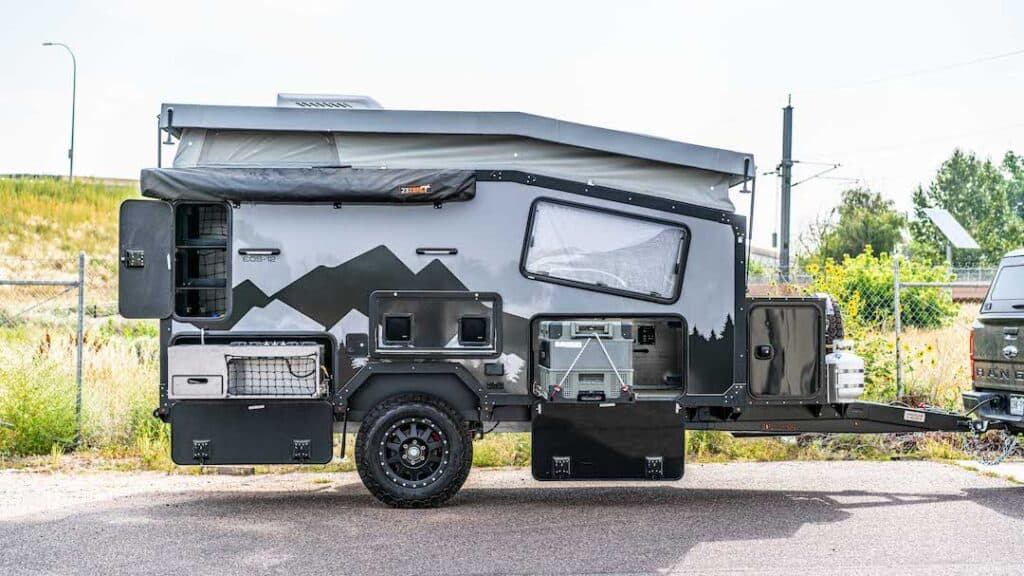
Pros
When it comes to taking care of the family, cooking, and staying clean, the EOS-12 is fully equipped with everything you need. It has features like an indoor wet bath, a 50-gallon capacity of freshwater, 25 gallons of greywater, a shower room option, and water filtration system.
But, don’t let the comforts fool you. This camper trailer is mighty capable with 20” of clearance for off-road capability, all-terrain tires, independent suspension, and more.
Cons
The Boreas EOS-12 takes the lead for the most expensive small RV on our list, with a starting price of almost $75,000.
BRX Trailers X2+
Born in my home state of North Carolina, BRX (founded as Blue Ridge Expedition Trailers) is building some serious hard-core overland trailers for any adventures you have up your sleeve.
- Sleeps: 5
- Bed arrangement: Queen bed, 3-person Thule Tepui Rooftop Tent
- Length: 16 ft 9 in
- Base weight: 2450 lbs
- Starting price: $44,000
- Additional info
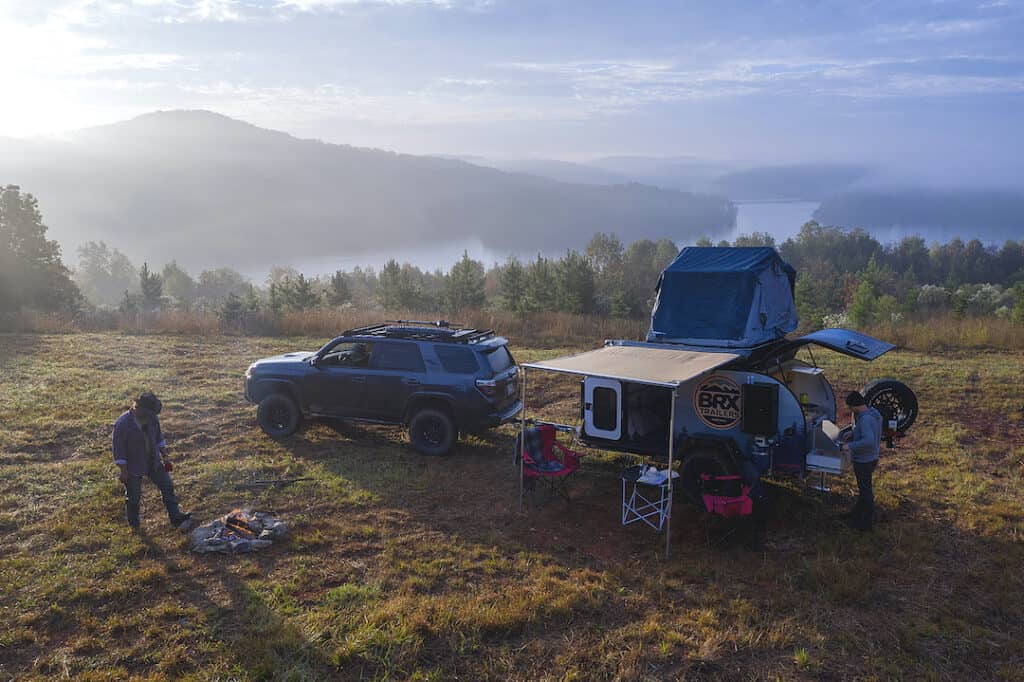
Pros
The BRX X2+ is fully equipped for getting you off the beaten path with offroad features such as a Max Coupler Multi-Axis Hitch, Timbren 3500 lb Axle-less Suspension, 22” of ground clearance, and more.
In addition, the X2+ has lots of other features, including a 3-person Thule Tupui rooftop tent making your sleeping capacity 5, an awning room, solar charging system, a Dometic 55 L cooler, an AC and heating unit, and a 2-burner Partner gas stove.
Bonus: At the time of publish in the fall of 2021, BRX is reporting a lead time of only 2-3 months, which is excellent news if you’re itching to get into a camper sooner than average!
Cons
At a starting price of $44,000, the X2+ is no small chunk of change, and they require a 50% deposit to secure your spot in line.
Best Camper Under 5,000 lbs for Family of 4 With the Most Privacy
Forest River R-Pod West Coast RP-201
If you’ve ever been to an RV show or lot, you’ve likely heard of Forest River. They have a lot of models available. However, the Forest River R-Pod West Coast RP-201 is our pick for the most privacy.
- Sleeps: 4
- Bed arrangement: Queen bed (in a closed-off bedroom), Convertible sofa bed
- Length: 25’
- Base weight: 4379 lbs
- Starting price: $32,948
- Additional info
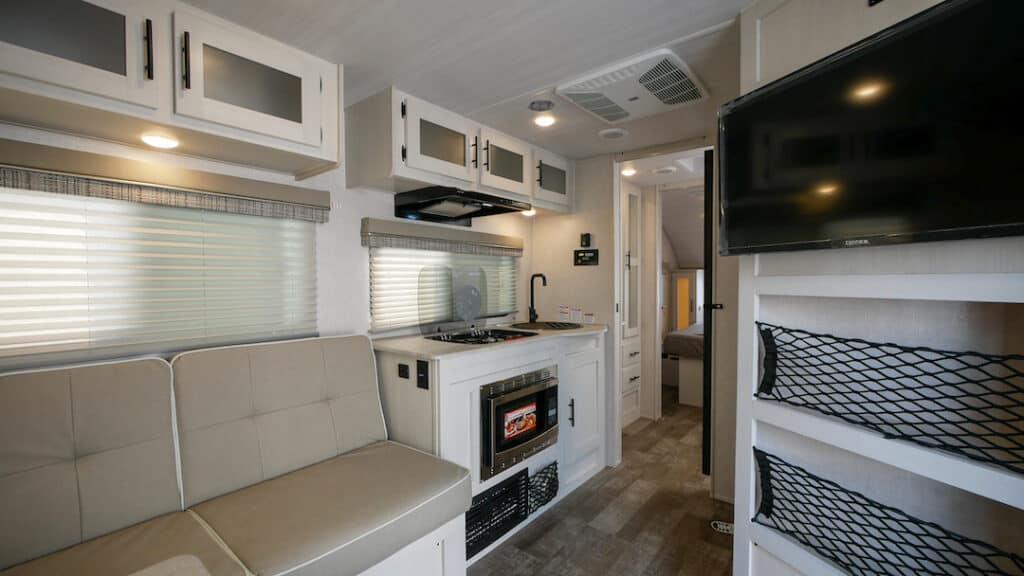
Pros
It has a separate bedroom! Do you really need to know anything else?! Kidding. Kind of. 🤪
Seriously though, this is the only camper that we have seen under 5,000 lbs that truly has an entirely closed-off bedroom, which is a huge perk.
Cons
That private bedroom comes at a cost, with this being one of the heaviest and longest campers on our list. At twenty-five feet, I’m not even sure I would call this a small camper anymore. Still, it is lightweight and offers a beautiful, comfy interior!
Best Tent Trailers
Opus OP4
The Opus OP4 (and OP2) are the Transformers of the tent trailer world. If your kids are anything like my boys were at five, owning one of these would win you cool points for life. Needless to say, if we ever buy one of these, I’m naming it Optimus Prime.
- Sleeps: 6
- Bed arrangement: 2 double beds (5’7” x 4’2”)
- Length: 17’ closed, 20’ open
- Base weight: 3100 lbs
- Starting price: $27,000, plus options
- Additional info
Pros
Okay, first of all, can we just talk about the ease of setup with this thing?! Let me just say that anything that makes setting up at camp easier as parents is a win. Opus delivered with their rapid deployment feature. You literally inflate the OP4 in under two minutes with the flip of a switch. 🤯
But that alone wouldn’t have made us include it on the list. This tent trailer also has plenty of sleeping space for families with two double beds and a seating area that can transform into a third bed. Plus, you can also make that front bed a King size with an optional extension.
With all that space, ease of use, and rugged features, this camper is ready for just about any adventure you can throw at it.
Cons
The biggest cons for us on the OP4 are similar to the OP15. Because we spend a lot of time adventuring when the weather is…well..less than stellar (or downright frigid), for us a camper trailer really needs to have an option for cooking indoors and a heater. Unfortunately, neither come standard on the OP4.
That said, even though they don’t come standard, you do have some options available as add-ons to address these cons:
- You have the option to add a Truma Furnace (16,000 BTU) propane heater or a Dometic Coolcat AC & Heatpump (10,000 BTU) to keep you warm in the winter.
- In addition, there are two options for creating a cover or enclosure over your outdoor kitchen, which may be enough for many people. Both the AIR Annex and the AIR Canopy are inflatable and attach to your camper. The AIR Canopy provides coverage from the sun and rain, while the AIR Annex also provides additional living space.
Ultimately, we still chose an option with an indoor cooking area because we regularly encounter high-wind snowstorms, but these options make our cons for the OP4 minor concerns.
Best Teardrop Trailers (Including Rugged Offroad Options)
TC Teardrops 5×10 (Overland option)
TC Teardrops is a small family-run business that makes each camping trailer one at a time for your family.
- Sleeps: 4 (2 adults and 2 small children)
- Bed arrangement: Main bed plus double bunk (58”x42”)
- Length: 14’6”
- Base weight: 1150-1200 lbs
- Starting price: $8500-$9,600, plus options (plan to double that if you want it fully loaded)
- Additional info
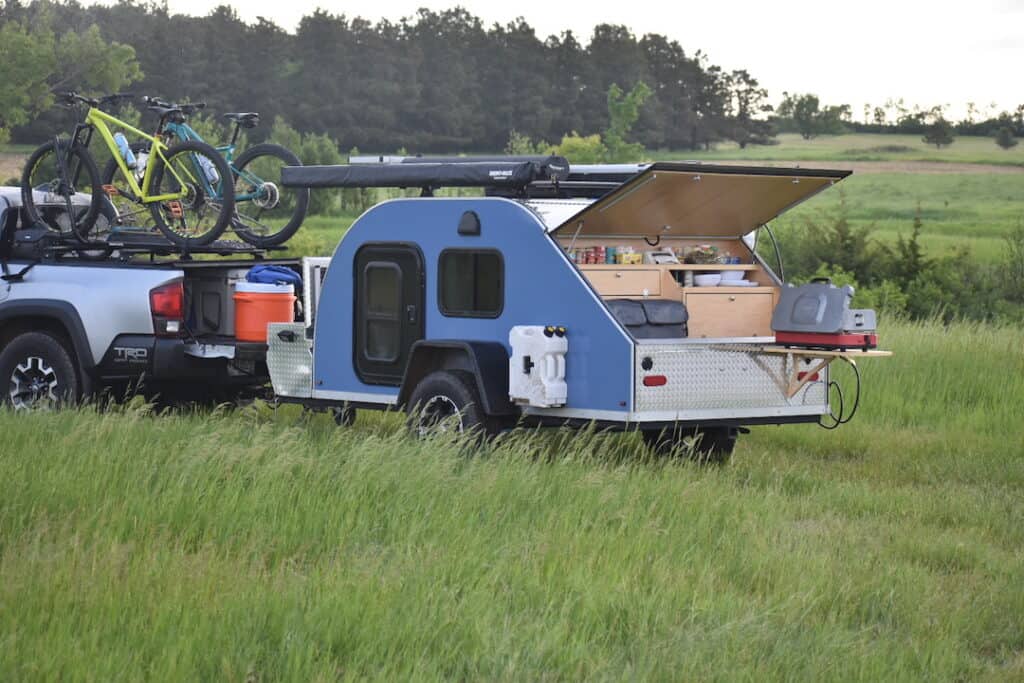
Pros
One of the most incredible things about this company is that because they custom-make their trailers, you have more choices than you do with some other options – including over 200 different colors for the sides of your camper.
In addition, the 5×10” allows for a single (21”W x 58” L) or double (42” x 58” L) bunk that can easily fit two small children. You also have the option of adding an awning and side tent for additional living and sleeping space.
The Overland model also includes upgrades on features such as Falken A/T Tires, 7” electric trailer brakes, Lock N Roll articulating hitch, and more.
Cons
The bunk bed is only 58”L, which means it’s really only suited for younger children (my 12-year-old is already too tall for this option).
Oregon Trail’r TerraDrop Alpha
The TerraDrop Alpha from Oregon Trail’r is another great option for an off-road capable teardrop.
- Sleeps: 2 (4 with added rooftop tent)
- Bed arrangement: Queen sized bed inside with optional rooftop tent
- Length: 8 ft
- Base weight: 1200-1500 lbs
- Starting price: $22,500 for TerraDrop Alpha, options added ala-carte
- Additional info
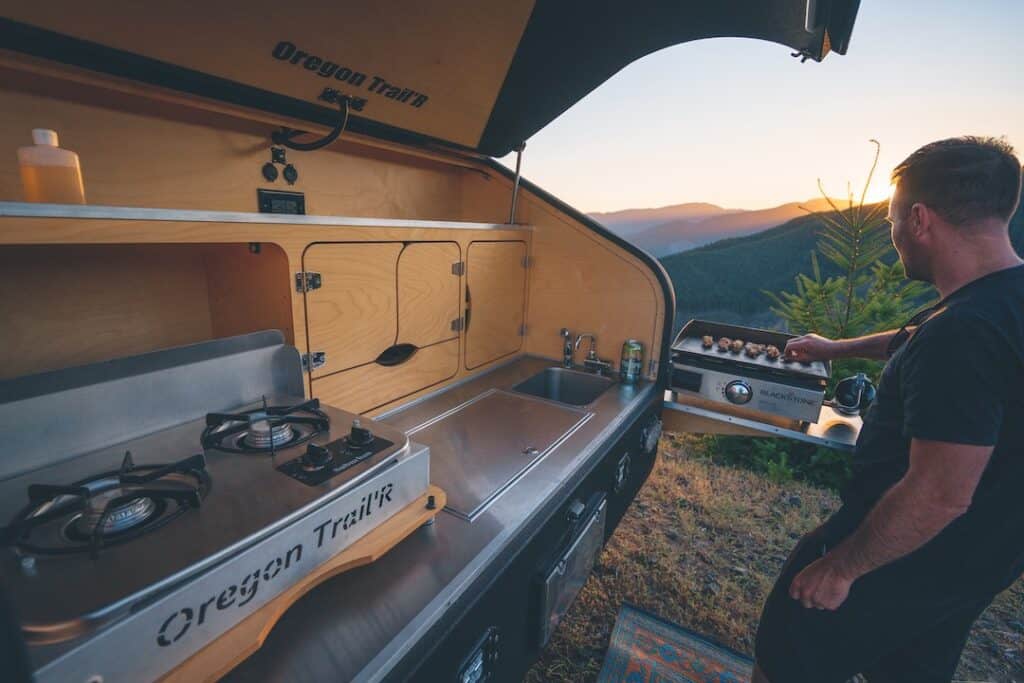
Pros
The ALPHA coating is designed to provide a durable seamless exterior, which means it will resist damage and keep you dry. The base-level package includes a welded-on wheeled tongue jack, off-road multi-axis coupler system, all-terrain tires, and more to truly take you where you want to go.
You have many options available to customize it just how you want, such as awnings, solar heated outdoor shower, solar connectivity, electric braking system, and more.
Cons
You’ll have to add the rooftop tent as a minimum to sleep four.
If you choose to fully load the trailer with most or all of the (many) available options, your price will jump significantly to $35-40,000.
Aero Teardrops The Steel
The Steel is the flagship model for Aero Teardrops, and it’s still around for a good reason. It’s functional, lightweight, and has everything you need to get out and adventure with your family.
- Sleeps: 2-4 with optional rooftop tent
- Bed arrangement: Main bed 54” x 80”, optional rooftop tent
- Length: 14 ft.
- Base weight: 1500 lbs.
- Starting price: $16,999
- Additional info
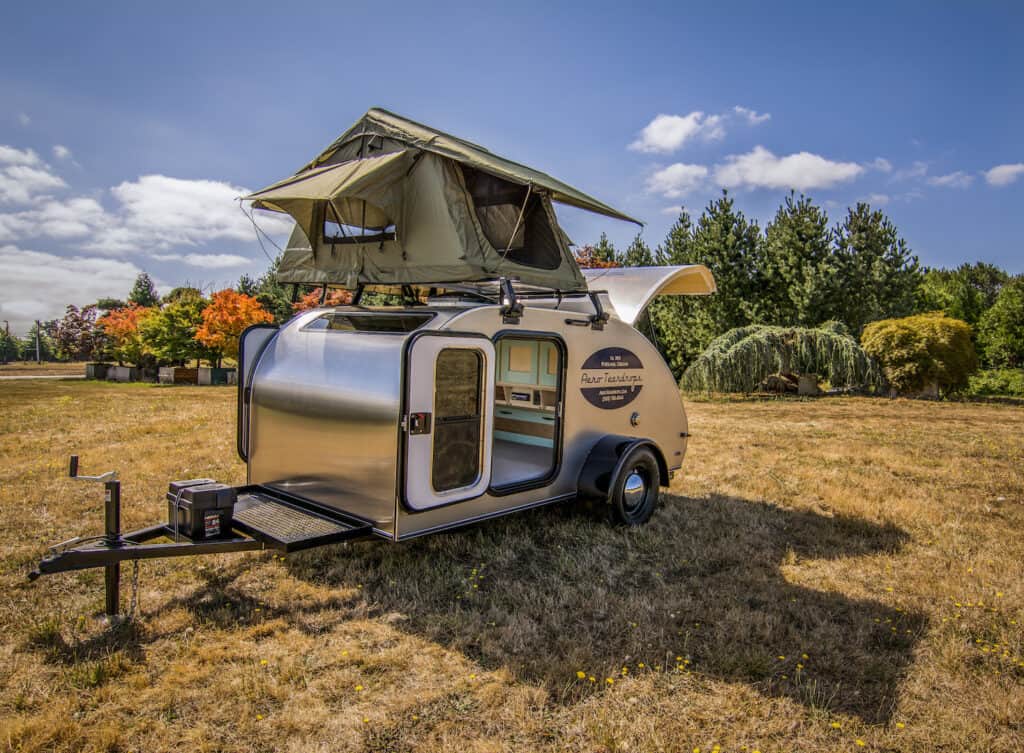
Pros
Aero Teardrops is a family-owned company from Tigard, Oregon (PNW for the win!)
Some of the features that stand out on this teardrop trailer are the ability to convert the upper cabinet into a bunk for a small child, the underfloor storage, and options to configure the galley to your preferences.
The Steel is also available in a High Clearance Package with oversize tires and wheels, heavy-duty axle, and Jeep-style fenders to get you out further on your adventures.
Cons
You’ll need to add the rooftop tent option to sleep a family of four.
Like most camper companies, their lead time is currently several months long. However, when available, they do list ready-to-buy trailers on their website as well.
Timberleaf Travel Trailers – The Classic
The Classic from Timberleaf Trailers is precisely what you would expect from its name – plus a whole lot more.
- Sleeps: 2 (4 with your own added rooftop tent)
- Bed arrangement: Main bed sleeps 2 (80” x 57”)
- Overall Length: Classic 168”
- Base weight: Classic 1500 lbs
- Starting price: Classic starts at $23,400, fully loaded $38,000+
- Additional info
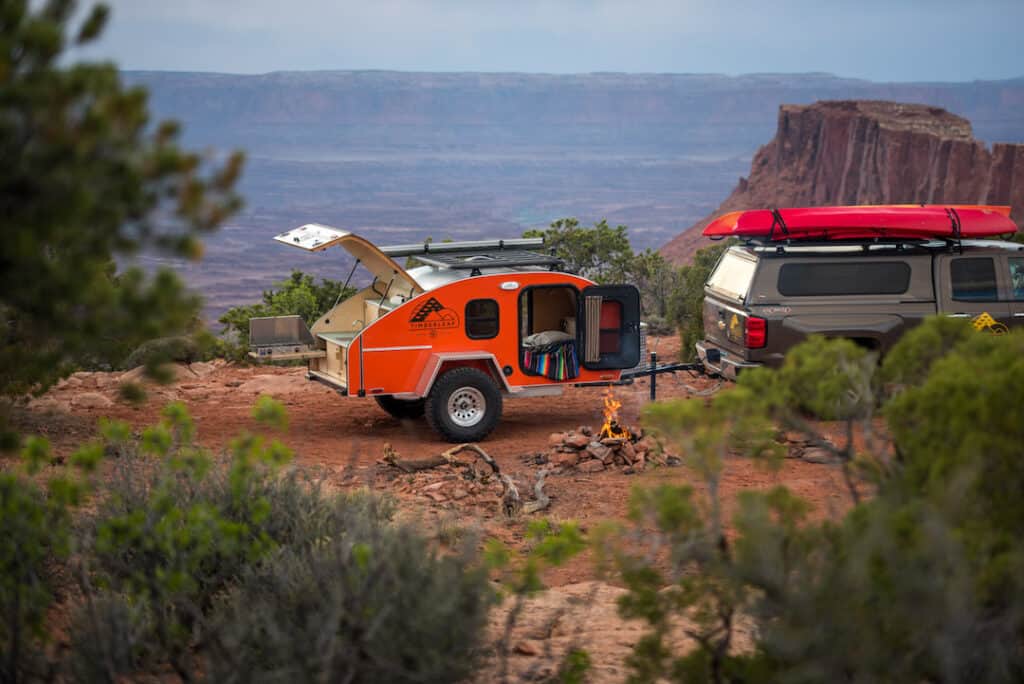
Pros
The design of this trailer truly is classic. But, the options and features are so much more. Timberleaf has some of the best options for customization that we’ve seen anywhere, allowing you to choose things like the color of your trailer and the countertop color and design. In addition, they have available options like off-road options, awnings, additional shelving, heaters, fans, and more.
Cons
In their build options, Timberleaf Trailers allows you to add a rooftop rack. However, there is no standard option to add a rooftop tent. That said, I emailed Timberleaf and they shared that they prefer to not limit your choices on tents, but they are happy to work with customers to ensure they get the option they need.
Colorado Teardrops Summit Pinnacle
The Summit Pinnacle from Colorado Teardrops is one of the toughest teardrops in their lineup and is meant to handle whatever adventures you have planned.
- Sleeps: 4+
- Bed arrangement: Queen bed and bunk beds that fold into a sofa
- Overall length: 173”
- Base weight: 1850 lbs
- Starting price: $32000
- Additional info
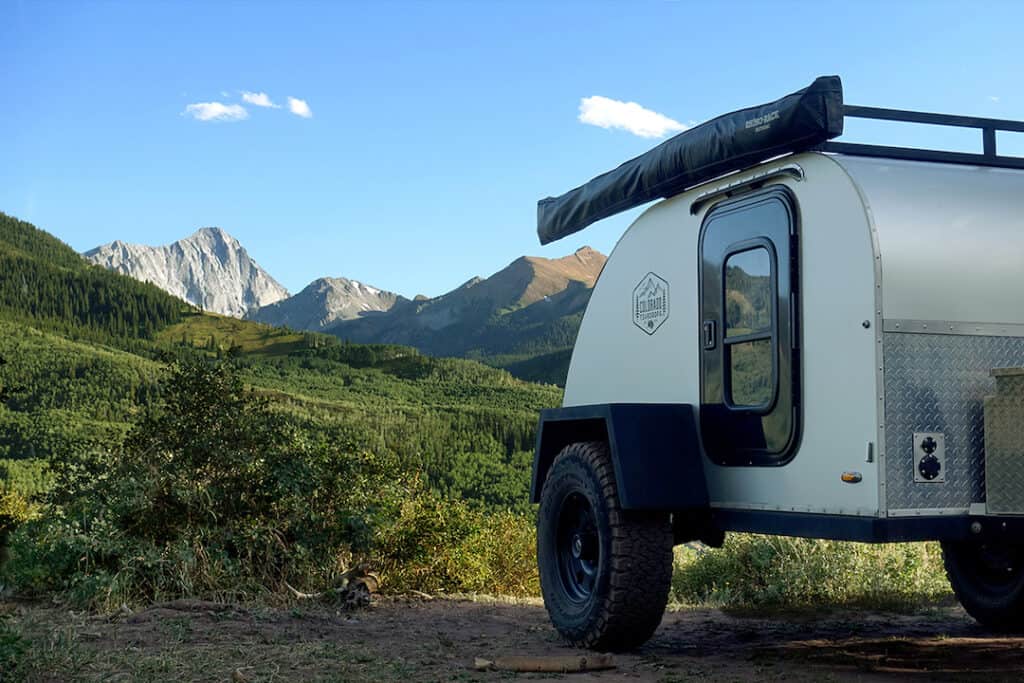
Pros
This camper trailer is genuinely designed for overland use with Timbren axle-less suspension, articulating hitch, rock sliders, and more. But don’t let that fool you. It’s also incredibly functional with under-floor storage, an outdoor galley kitchen, and optional on-demand hot water and shower.
Cons
They aren’t the least expensive option out there, and your price will creep closer to $40,000 fully loaded.
Note: If you don’t need overland use, consider their Mount Massive Teardrop. With a dry weight of 1470 lbs, sleeping space for 4, and a starting price of $26,500, it’s another great option for your adventures.
Best Small Truck Bed Campers
If you have a car or SUV, you can go ahead and jump right to the next section. If you have a truck but still want a lightweight camper with a smaller footprint and without having to tow on overland adventures, a truck bed camper can be a great option.
Choosing the Best Lightweight Truck Bed Camper
Payload vs. tow capacity
When you’re looking at the weight of truck bed campers, one thing to keep in mind is that your tow capacity on a truck might easily be 10-15,000 pounds. But, don’t be fooled. That is NOT the same as your payload capacity, which is what you’ll need to take into account for a truck bed camper.
For instance, our Ford F350 has a towing capacity of 20,000, but our payload capacity is around 3,700. And, that weight technically needs to include your camper, supplies, and the people you’ll have in the vehicle. Yes, some people will push this and never have issues, but when we’re hauling our kids and gear on forest service roads away from easy service, that’s not something I’m willing to risk.
Truck bed length/bed closure
Depending on the length of your truck bed and the camper you choose, you may need to take the tailgate off completely. However, some options may allow you to close the tailgate or leave it in place for a bit of a “porch.” If being able to leave the tailgate on and close it is very important to you, make sure you measure for clearance to ensure fit.
Scout Campers Kenai
If you’re looking for a camper that can accommodate a family of four, is still lightweight, and you don’t really want to tow a trailer, this is your pick!
- Sleeps: 4+
- Bed arrangement: Queen-size bed over the cab, optional rooftop tent, and convertible dinette.
- Overall length: 145.5”
- Base weight: 1370 lbs, 1908 lbs fully loaded with options including rooftop tent, awning, jacks, fridge, etc.
- Starting price: $24,900, fully loaded comes in around $37,000
- Additional info
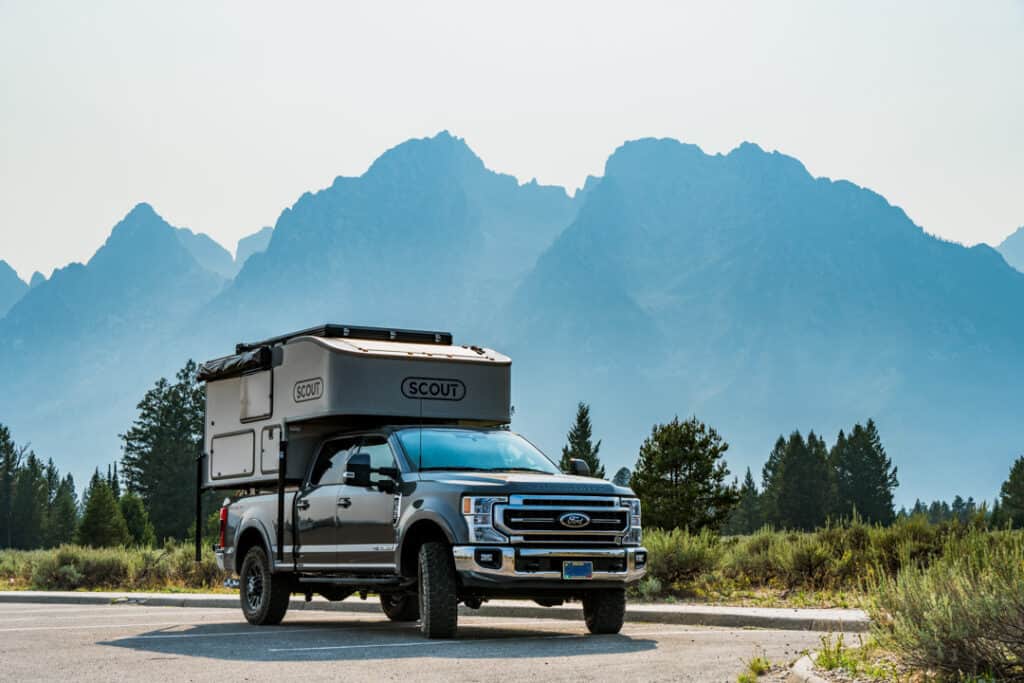
Note: If you don’t need the shower option or additional storage, Scout also has two lighter weight smaller options, the Olympic (base weight 1133 lbs) and the Yoho (958 lbs)
Pros
The Scout Kenai has a perfect balance between comfort and functionality while maintaining a minimalist design and relatively small size. It can give you the features you need without sacrificing weight by using simple systems and features instead of heavier, more complex choices.
We love the sleeping options for 4+ that include a queen-sized bed over the cab, a Roofnest roof top tent, and a convertible dinette. Though, to be fair, the dinette is best suited for small children.
The 4-season insulation and Newport Real Flame Fireplace are perfect for skiing or snowboarding in the Pacific Northwest and beyond. Plus, the drain pan area works great for the optional shower kit but also for hanging your snow gear to dry.
With reinforced aluminum framing, optional indoor/outdoor cooktop, hanging storage bags, and more, it can be outfitted with everything you need and nothing you don’t.
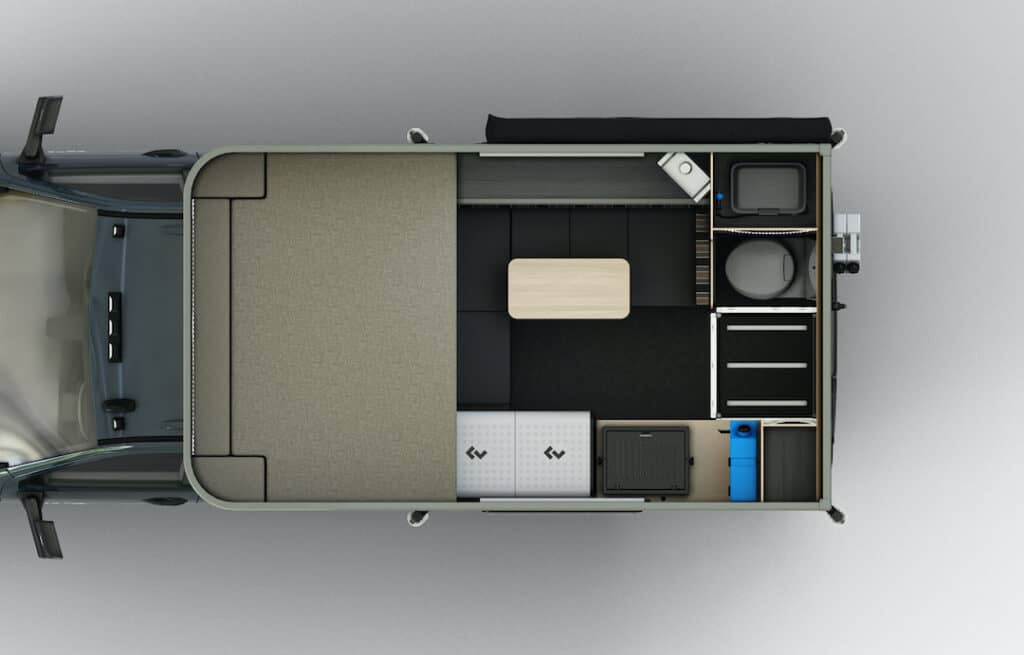
Cons
Many of the options that make it perfectly equipped do not come standard at the base price. The beauty of that is that you don’t pay for features you don’t need or care about.
If you opt for the RinseKit shower, plan on it pulling a lot of power from your solar-powered Goal Zero Yeti 1500X to heat. It’s great for summer adventures as the water is comfortable from the heat of the day. If you want hot water in winter, the Joolca water heater might be a better choice. In addition, it has no onboard gray water system. However, that is easily remedied by attaching a hose and collection container.
While the Kenai does have a heater for those cold winter nights, there is currently no option for air conditioning. You can open the windows and turn on the small fan, but it’s not likely to keep you cool on the hottest of summer days.
Best Unique Camper Trailer (for Electric Vehicles!)
Colorado Teardrop Campers – The Boulder ™
The Boulder™ from Colorado Teardrop Campers is so innovative I simply couldn’t leave it off the list. Made specifically for owners of electric vehicles, it’s made in Colorado and ready for all seasons.
- Sleeps: 4
- Bed arrangement: Queen, 2 bunk beds
- Overall length: 195”
- Base weight: 1950 lbs
- Starting price: $55,000 (with current preorder pricing, you can save up to $10,000 and have one of the first models available)
- Additional info
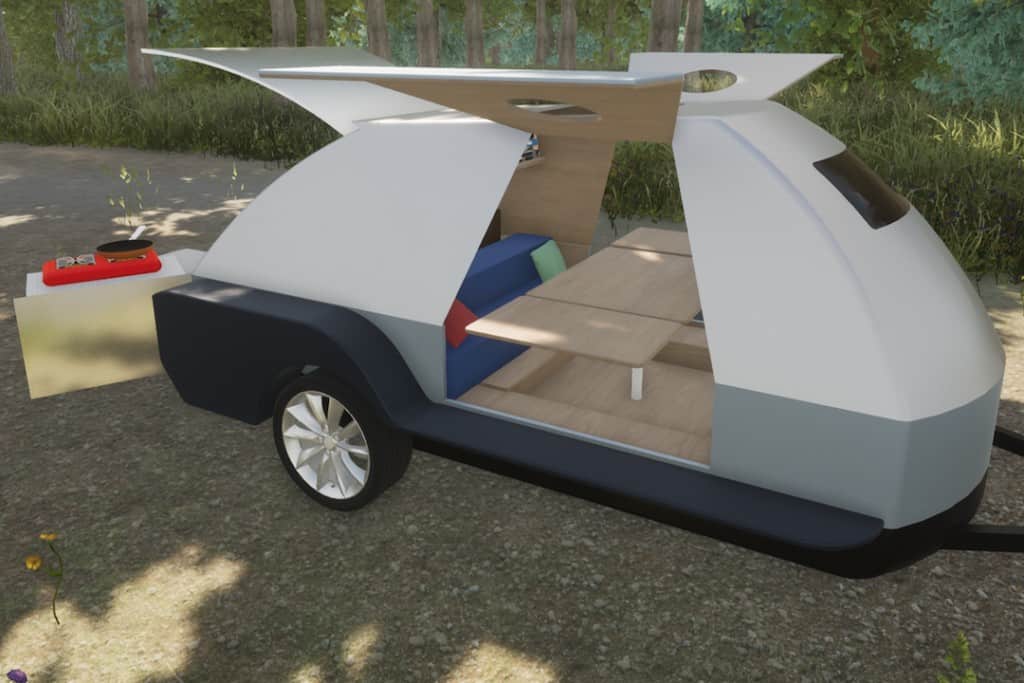
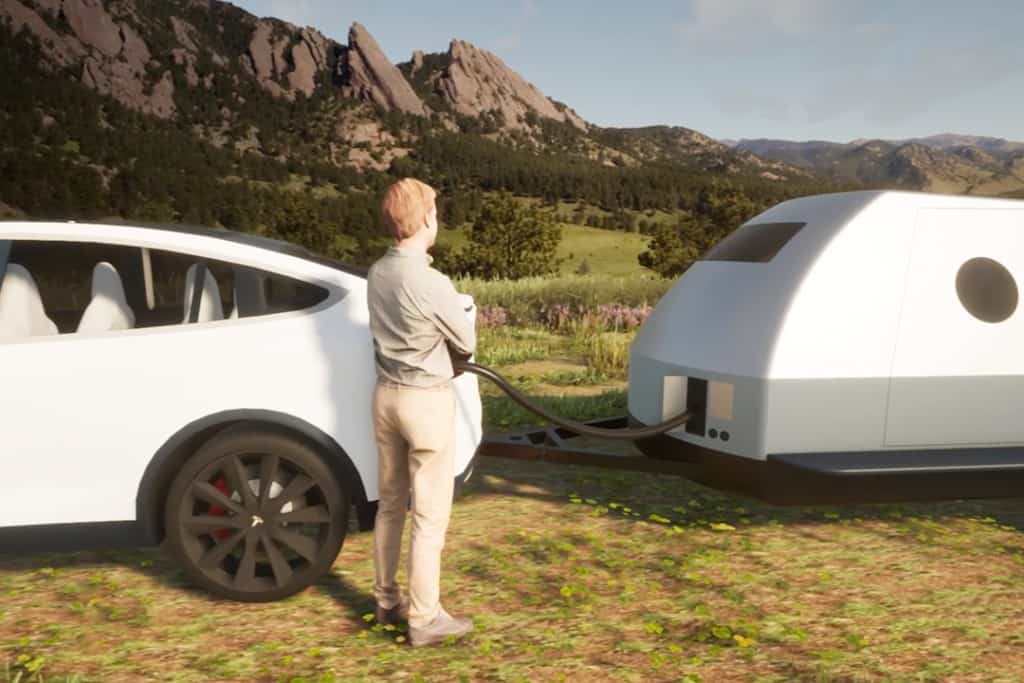
Pros
The Boulder™ has a fully insulated cabin, galaxy-gazer window, large galley, and a bank of EV batteries that allows you to recharge on your adventures. Because towing with an EV decreases your range, the extra bank of batteries means you’ll be able to go further on your adventures. According to Colorado Teardrop, the bank should get you the equivalent of its non-towing range or more.
Cons
They aren’t available quite yet. And, they certainly aren’t the least expensive out there. But, if you reserve yours now, you can save a large chunk off the list price and get several perks for being the first to order.
What to Look for When Choosing the Best Small Camper for a Family of 4
Okay, so now what? You’ve seen our top picks for the best small campers for families of four. But, how do you choose the best one for YOUR family?
Here are some things we think are the most important to consider a camper that works for the whole family. In fact, they are the things that we took into consideration when choosing our camper.
What is Most Important to You
The truth is that no matter which camper you choose, there are likely to be some compromises. Just like buying a house or a car, you’re unlikely to find one that checks every single item on your wishlist. So, it’s super important to decide what your priorities are as a family when you’re buying so that you can filter your options through and make the best decision for yourself.
For example, here are some questions to ask yourself as you prioritize your options:
- Where do you plan to use your camper?
- What time of the year do you want to camp?
- How long do you expect your trips to be?
- What can your tow vehicle handle?
- Is the floor plan functional for you?
- Is an indoor kitchen a must?
- What sleeping arrangements will work for your family? What about in a few years when your kids have grown?
- Is there enough storage (or can you add extra) to accommodate your family?
- What can you budget for your camper?
- How much maintenance are you willing to do?
Where You Plan to Use It
This is a huge consideration and one of the key decision-makers for us. If you’re planning to use your camper primarily on the highway and in major campgrounds, any of these options will be suitable.
However, if you have plans to explore any forest service roads, have overlanding dreams, or plan to do hard-core off-roading, your needs are going to be completely different. We knew we wanted to explore forest service roads and overland, so a model built for that type of use was key.
The other factor in where you want to use your camper is your physical location. For instance, if you live in Florida or the Southwest, you will probably prioritize a unit with air conditioning. If you’re in the Pacific Northwest like us, a heater is probably the bigger priority.
When You Want to Use it
Next on the priority list is when you want to use your new camper. For instance, if you only plan to use your camper during spring, summer, and early fall, you have plenty of choices. But, if you plan to do any winter camping or use your camper as a base for winter sports like skiing or snowboarding, you’ll want to choose a camper that will keep you warm and is equipped for travel on the snow.
Maintenance Requirements
One of the things we realized when we were looking is that the maintenance requirements for small campers can vary. A LOT.
Many small trailers are fully equipped with all niceties, including freshwater, greywater, and black tanks, requiring more work to clean out. Some also need winterizing every season. Others are more simple and require very little maintenance other than cleaning and general upkeep.
It’s worth it to spend a little time researching the requirements for your top contenders and deciding if the maintenance requirements fit into your schedule – and budget.
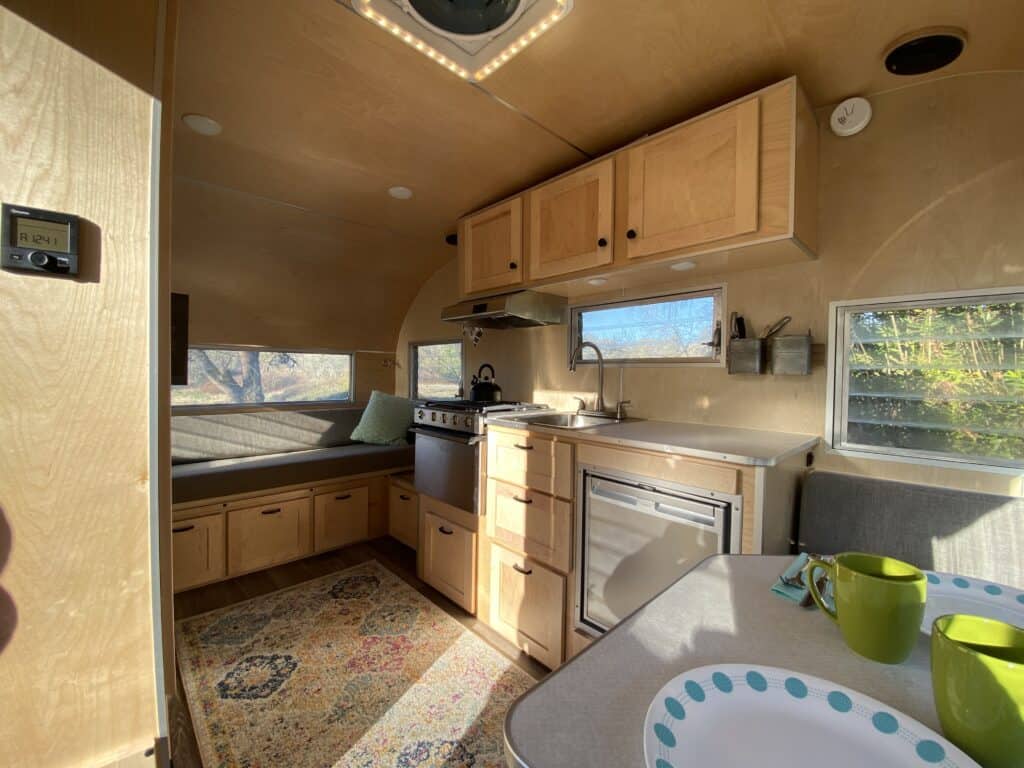
Length of Trips
Knowing how often and how long your trips typically are can help you decide what is best for you as well. Do you love to road trip, or are you just planning to use it at a few local campgrounds each year?
For instance, we plan to take a couple of weekend trips a month and a handful of longer trips each year, so a smaller, easier to maneuver option is perfect for us. If we were planning to live in our camper full-time, let’s just say I think the only choice on this list would be the R-Pod. Mama occasionally needs her private space for sanity. 🤪
Functional Floor Plan
Okay, so this is one of the most essential things, in my opinion. Though it’s still an opinion, so take it as you wish. For us, having a camper that required beds to be set up and taken down every. single. night. was not an option.
We’ve spent some time renting campervans and RV’s that required sleeping spaces to be converted to seating spaces or dining spaces, and it drives me up the wall. I feel like even if we’re at a site for a week, I never feel settled having to set up and take down each night. We were open to a camper that required a quick set upon arrival at camp for one or more beds, but not a complete setup and takedown each day.
That said, I know when you’re looking at small campers, space is at a premium, so it might be hard to find an option that doesn’t require some conversion. And, that’s okay. As long as the trade-offs in the rest of the floorplan work for you.
Sleeping Arrangements
This is one of my biggest pet peeves in the RV world. When we first started looking, we saw so many campers that claimed to have sleeping space for four.
Bologna.
They might have enough sleeping space if you’re children are teeny tiny adorable babies and toddlers.
But, guess what? Those babies and toddlers grow up FAST, and sometimes they end up at 5’4” with bigger feet than you before they even hit twelve. And, they aren’t slowing down anytime soon.
So, a convertible “bed” that’s 24 inches wide and 48 inches long is a cop-out, in my opinion. Or when they expect two “people” to sleep on a space marginally bigger than a twin bed. Even when our kids were smaller, that would have been a nightmare to get them to sleep and hear “his feet are on my side” a bajillion times.
All I’m saying is to take into consideration what you need now, but also what you’ll need as your kids grow.
Food and Gear Storage
This falls back a bit to some of the things we’ve already mentioned. If you’re only taking weekend trips, you’ll need a lot less storage. But, if you plan to be off-grid for weeks at a time, you’ll want to make sure you have plenty of storage for your food and clothing.
Another thing to consider is what activities you plan to do when you’re camping. If you plan to do winter sports, biking, or other activities, consider how you will fit your gear.
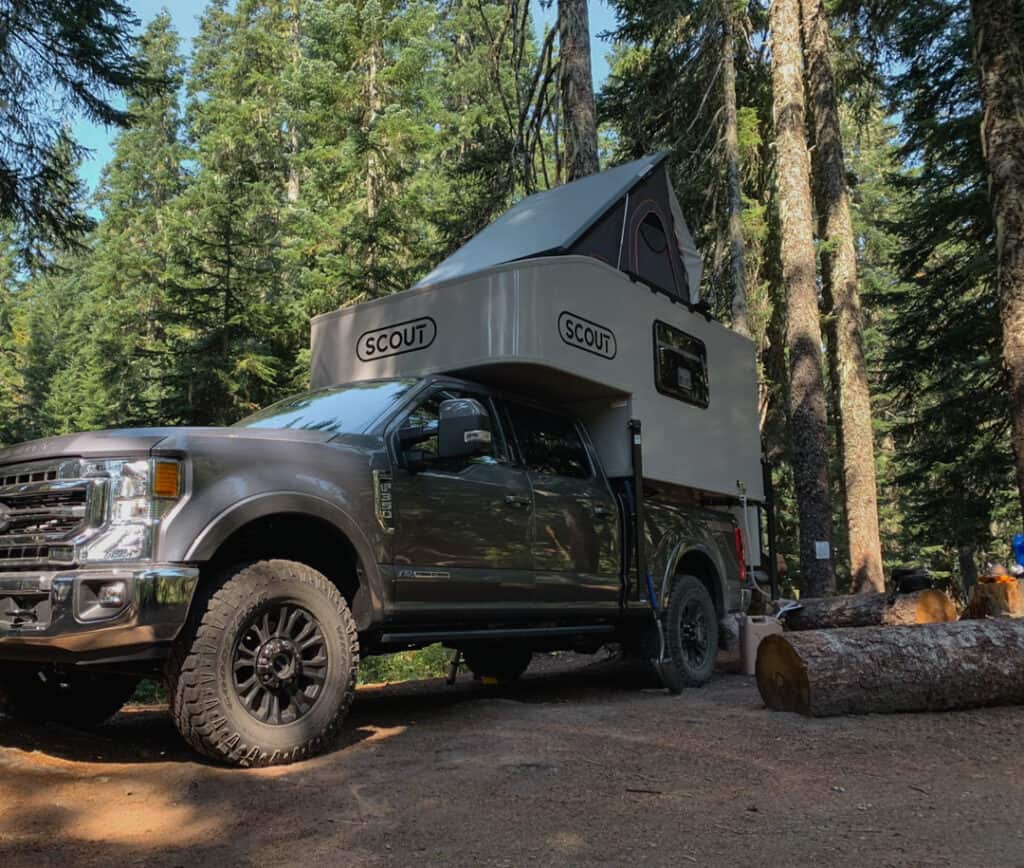
More things to Consider When Buying a Small Camper for Your Family
Aside from the features specific to each camper, there are a few other things to consider when purchasing your new RV.
Size and Age of Your Kids
As I mentioned earlier, choosing a camper with adequate sleep space to grow with your family is a priority. However, another thing to consider is if you have older teens, they may not go with you on every trip due to other obligations, and they’ll likely be moving out or going to college soon, so something like a convertible sleep space might be totally fine.
Your Tow Vehicle
A key thing to include in your choice is what vehicle you will be using. You’ll need to know the towing capacity of your vehicle if you decide to go with a teardrop or small trailer. However, if you’re planning on a truck bed camper, make sure to consider the payload of the camper, your family, and your gear as you’re making your choice.
Cost
As you probably noticed, the costs for small campers can vary widely. You can start with a simple teardrop camper for around $10,000, or you can go all out for fully loaded options and spend $75,000 or more!
Because they vary so much in price, it’s a good idea to look at your budget, savings, and financing options before you fall in love with a particular model.
Should You Consider Alternate RV Types
Lastly, you may want to consider if a different type of RV would be better suited to your family of four. There are many different options – all with their own sets of pros and cons – but if you’re still not sure, some options to consider are:
- Class A RV’s – You know those RV’s that look like a tour bus? Yup, that’s a Class A. They are big, comfortably appointed, and can set you back anywhere from $40,000 to a few hundred thousand.
- Class B RV’s or Campervans – If we hadn’t gone with a small RV, a campervan would have been our choice. They can be built from several different sizes of vans, but our favorites are those on the Sprinter chassis. You can find options with proper seating for a family of four (hard to find in many driveable RV’s) and all the amenities you could dream up. DIY builds are very popular if you’re looking to save some money, or you can have custom builds done that can range from $50,000 to several hundred thousand dollars.
- Class C RV’s – Class C campers are built with a cab attached to the camper. They are smaller than Class A’s but drive more like a regular vehicle.
- Toy Hauler – A toy hauler is a bigger camper trailer that has plenty of room for – you guessed it – your toys. If you love to ride dirt bikes, ORV’s or just need an ample garage storage space, these could be the best option for you!
- Fifth Wheel – Fifth wheels are large camper trailers that use a special mount in the truck’s bed. They are popular because they provide more space and are more stable than other campers of similar size.
We only really considered the Class B, Toy Hauler, or Fifth Wheels out of all these. Despite our best efforts, we have never found a Class A or C RV that has seating for all four of us that we are comfortable with.
And, I know…there’s a lot of opinions on this, but I have trusted Car Seats for the Littles for years for sharing the facts and data related to car seat and child vehicle safety. When we were looking for an RV, I went straight to their site and found this article about RV Travel with Children to help us make our decision.
Which Small Camper Did We Pick For Our Family of Four?
Drum roll please…🥁
After much consideration (and a VERY close second from Black Series), we landed on a Scout Kenai for our family.
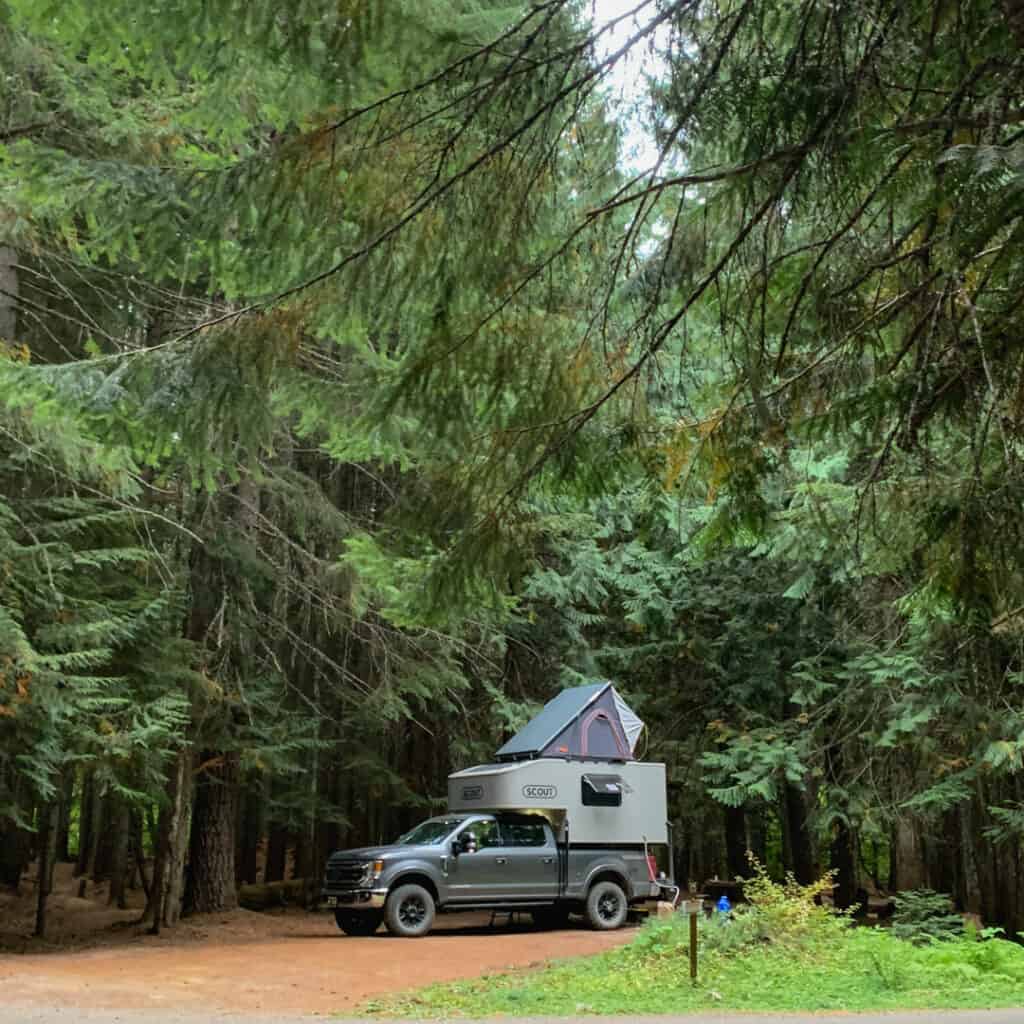
It was a tough decision, but ultimately, we made our decision based on a few key factors:
- We planned to use the camper all year round.
- It has enough room to sleep 4 regular-sized adults. Our oldest is almost as tall as me at 12, and he isn’t slowing down. 😅
- We spend a lot of the winter in the snow, and we weren’t keen on towing in the snow and ice if we didn’t have to. (And, by we, I mostly mean me. 😆)
- A camper with a heater and options to sleep 4 INSIDE was essential for us (though, to be honest, it will be a little tight if we don’t use the rooftop tent).
- We wanted simple functionality instead of fancier systems that require more time and money to maintain.
- It was important for us to have solar power, so the option for the solar panel and Goal Zero Yeti 1500X was huge for us.
Will it be perfect? Of course not. There are trade-offs no matter which option we chose, and the same will be true for you.
Which Small Camping Trailer Should You Choose?
I wish I could give you a one-size-fits-all answer, but the truth is, there isn’t one. Your family is unique in your needs, so what I find essential might not be the same for you.
Ultimately, after learning about the best small RV’s for a family of four, we suggest you make a list of the key features that are non-negotiable for your family, as well as features on your wishlist, and find one that ticks the most boxes.
Then, if you have the chance, see one in person or find one to rent on Outdoorsy.
If that doesn’t work, get creative!
For instance, we couldn’t see a Kenai in person before we ordered, but we were able to see another model by Scout, which helped us feel confident.
If you know someone who owns the camper you’re thinking of, ask them if you can take a tour – even if you only “met” them online. Seriously. People love showing off their gear, and I’ll bet you get a yes!
After taking a look through our list, which small RV stands out for you and your family?

